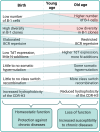The immunology of B-1 cells: from development to aging
- PMID: 39095816
- PMCID: PMC11295433
- DOI: 10.1186/s12979-024-00455-y
The immunology of B-1 cells: from development to aging
Abstract
B-1 cells have intricate biology, with distinct function, phenotype and developmental origin from conventional B cells. They generate a B cell receptor with conserved germline characteristics and biased V(D)J recombination, allowing this innate-like lymphocyte to spontaneously produce self-reactive natural antibodies (NAbs) and become activated by immune stimuli in a T cell-independent manner. NAbs were suggested as "rheostats" for the chronic diseases in advanced age. In fact, age-dependent loss of function of NAbs has been associated with clinically-relevant diseases in the elderly, such as atherosclerosis and neurodegenerative disorders. Here, we analyzed comprehensively the ontogeny, phenotypic characteristics, functional properties and emerging roles of B-1 cells and NAbs in health and disease. Additionally, after navigating through the complexities of B-1 cell biology from development to aging, therapeutic opportunities in the field are discussed.
Keywords: Aging; Autoantibodies; B cell development; B-1 cell; Immunology; Natural antibody.
© 2024. The Author(s).
Conflict of interest statement
The authors declare no competing interests.
Figures




Similar articles
-
Natural Antibodies: from First-Line Defense Against Pathogens to Perpetual Immune Homeostasis.Clin Rev Allergy Immunol. 2020 Apr;58(2):213-228. doi: 10.1007/s12016-019-08746-9. Clin Rev Allergy Immunol. 2020. PMID: 31161341 Review.
-
Fundamental roles of the innate-like repertoire of natural antibodies in immune homeostasis.Front Immunol. 2013 Feb 5;4:4. doi: 10.3389/fimmu.2013.00004. eCollection 2013. Front Immunol. 2013. PMID: 23386848 Free PMC article.
-
Manipulation of the glycan-specific natural antibody repertoire for immunotherapy.Immunol Rev. 2016 Mar;270(1):32-50. doi: 10.1111/imr.12397. Immunol Rev. 2016. PMID: 26864103 Free PMC article. Review.
-
B-1 cell immunoglobulin directed against oxidation-specific epitopes.Front Immunol. 2013 Jan 9;3:415. doi: 10.3389/fimmu.2012.00415. eCollection 2012. Front Immunol. 2013. PMID: 23316200 Free PMC article.
-
A Special Connection between γδ T Cells and Natural Antibodies?Arch Immunol Ther Exp (Warsz). 2016 Dec;64(6):455-462. doi: 10.1007/s00005-016-0403-0. Epub 2016 May 27. Arch Immunol Ther Exp (Warsz). 2016. PMID: 27235134 Free PMC article. Review.
Cited by
-
The role of autoantibodies in Alzheimer's disease: Pathogenetic connections or epiphenomena?Alzheimers Dement. 2025 Jul;21(7):e70484. doi: 10.1002/alz.70484. Alzheimers Dement. 2025. PMID: 40696840 Free PMC article. Review.
-
B cell development: transcriptional regulation and immunological mechanisms in homeostasis.Front Immunol. 2025 Aug 8;16:1593338. doi: 10.3389/fimmu.2025.1593338. eCollection 2025. Front Immunol. 2025. PMID: 40861439 Free PMC article. Review.
-
Immune regulation: a new strategy for traditional Chinese medicine-based treatment of granulomatous lobular mastitis.Front Immunol. 2024 Oct 31;15:1494155. doi: 10.3389/fimmu.2024.1494155. eCollection 2024. Front Immunol. 2024. PMID: 39544943 Free PMC article. Review.
-
The Role of NADPH Oxidase 2 in Leukocytes.Antioxidants (Basel). 2025 Mar 4;14(3):309. doi: 10.3390/antiox14030309. Antioxidants (Basel). 2025. PMID: 40227295 Free PMC article. Review.
References
Publication types
LinkOut - more resources
Full Text Sources

